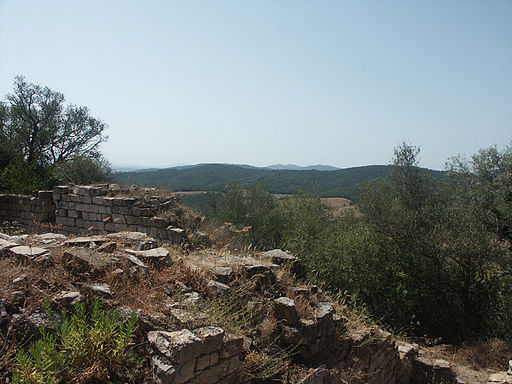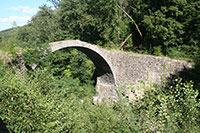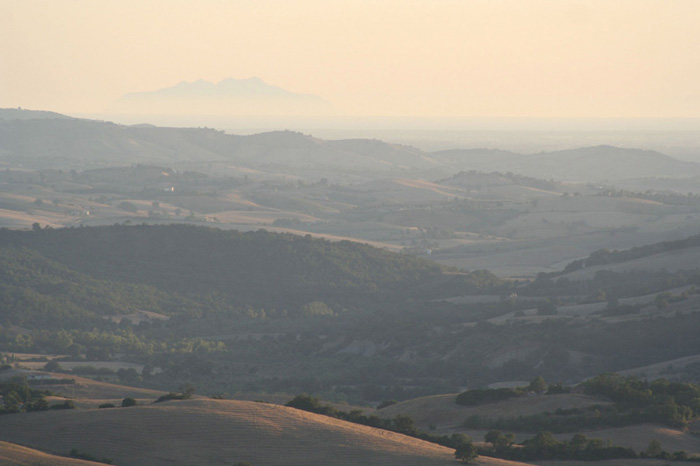| |
|
The Palazzo Tolomei is an imposing, Gothic style urban palace, located on Via Banchi di Sopra in the present contrada of Civetta, Terzo di Camollia of the city of Siena.
The building is one of the oldest palaces in the city and was erected between 1270 and 1275 by the Tolomei family. It served as the first permanent headquarters of the Sienese commune during the early years of the Guelph era, before the construction of the Palazzo Pubblico in the Piazza del Campo, and it also functioned as a bank and private residence.[1] It stands on the west side of the Piazza Tolomei, across from the church of San Cristoforo. The aristocratic Tolomei family for many years was associated with this parish church.[2] On the Via Banchi di Sopra, it is a few houses south and across the street of the Palazzo Bichi Ruspoli, a few blocks north of the Piazza del Campo.
The original palace of this Guelf aristocratic family was mostly destroyed by Ghibelline mobs in 1267 but was rebuilt in its current form shortly after the new Guelph regime came to power. The stone palace, with its tall first floor, mullioned windows with trefoil decoration in upper floors, was restored in the 1960s and is now home to Banca CR Firenze.
Among the most notable members of the Tolomei family was Pia de' Tolomei, who lived in the thirteenth century. In 1295, however, she was supposedly murdered by her Guelph husband from the Maremma, who wished to remarry. Her story was popular in the 19th century as a symbol of faithfulness to principles in the face of treachery and self-interest.
|

|
Plaque on palace wall [2]
|
Gaetano Donizetti made her the subject of his tragic opera, Pia de' Tolomei. She was initially immortalized by Dante, who encounters her in Purgatory (English translation by T.S. Eliot):[3]
“Deh, quando tu sarai tornato al mondo,
e riposato della lunga via,”
seguitò il terzo spirito al secondo,
“ricorditi di me, che son la Pia;
Siena mi fe’, disfecemi Maremma:
salsi colui che innanellata, pria
disposando, m’avea con la sua gemma.”
“O pray, when you return to the world,
and are rested from your long journey,”
followed the third spirit after the second,
“remember me, who am La Pia.
Siena made me, Maremma unmade me:
this is known to him who after due engagement
wedded me with his ring.”
The Tolomei family also bore Saint Bernardo Tolomei and the Blessed Nera Tolomei, memorialized in the facade of the church of San Cristoforo. In front of the palace stands a column crowned with a Roman She-wolf.
|
 |
|
 |
|
 |
The ruins of Castel di Pietra
|
|
Il Ponte della Pia
|
|
Dante Gabriel Rossetti, La Pia de Tolomei, between 1868 and 1880, Spencer Museum of Art
|
The Tolomei family also bore Saint Bernardo Tolomei and the Blessed Nera Tolomei, memorialized in the facade of the church of San Cristoforo. In front of the palace stands a column crowned with a Roman She-wolf.
|
| |
|
|
|
|
|
|
|
| |
|

|
|
|
|
|
 |
|
 |
|
 |
Basilica di San Francesco, Siena |
|
Piazza del Campo, visto dalla cima di Torre del Mangia
|
|
Piazza Salimbeni
|
Urban trekking in Siena | Piazza del Campo - Basilica di San Francesco - Fortezza Medicea | 2,9 km
Piazza del Campo - Banchi di Sopra - Palazzo Tolome - Chiesa di san Cristoforo -Via del Moro
- Piazza Provenanzo Salvani -Chiesa di San Francesco -Via dei Rossi - La Dama Ignuda - Palazzo Salimbeni - Via dei Montagnini -Piazza Giacomo Matteotti - La Lizza - Fortezza Medicea
|
|
San Francesco en La Fortezza (2,9 km)
|

Case vacanza in Toscana | Podere Santa Pia
|
 |
Podere Santa Pia, an enchanting holiday home in the heart of southern Maremma, with a suggestive view towards Monte Amiata, the islands Montecristo and Corsica immersed in the intense blue of the Tyrrhenian Sea.
|
Bibliografia
Toscana. Guida d'Italia (Guida rossa), Touring Club Italiano, Milano 2003.
Max Grossman, «A Case of Double Identity: the Public and Private Faces of the Palazzo Tolomei in Siena», Journal of the Society of Architectural Historians, 72, no 1, March 2013, pp. 48-77.
Giulio Prunai, Guido Pampaloni et Nello Bemporad, Il Palazzo Tolomei a Siena, Florence, Cassa di Risparmio di Firenze, 1971.

[1] Photo by Jordiferrer, licensed under the Creative Commons Attribution-Share Alike 4.0 International license.
[2] Photo by Sailko, licensed under the Creative Commons Attribution 3.0 Unportedlicense.
|
° This article incorporates material from the Wikipedia article Palazzo Tolomei (Siena), published under the GNU Free Documentation License.
|
| |
|
|
|
|
|
|
![]()







